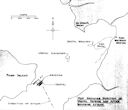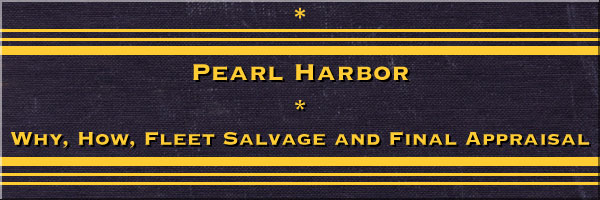
CHAPTER XII
Getting the Less Damaged Ships Ready For Action
As mentioned before the first aim of the high command was to get the less damaged ships ready as soon as possible for action. This work engrossed "all hands" around the clock. The crews themselves did considerable work in getting their ships ready. They were assisted by repair ships, tenders, tugs, and by the Navy Yard.
As yet there was a dire shortage of pumping equipment, lumber, and other materials necessary for efficient salvage work. However, the spirit of the times was "to do our best with what we had." Each echelon of command did everything possible to overcome obstacles which were encountered.
1. U.S.S. PENNSYLVANIA, BATTLESHIP (LAUNCHED IN 1915 )
The lightly damaged Pennsylvania gave promise of being one of the first ships to be ready for action. The Navy Yard expedited the lining up of her shafts and propellers. One of the 5-inch anti-aircraft guns was put out of commission temporarily and one 5-inch 51 caliber gun was seriously damaged by the same 250 kilogram bomb which exploded two decks below. The latter was replaced by a gun from West Virginia. The fragmentation and explosion damage was quickly overcome. The splinter protection, wooden deck, electrical gear, water mains, and structural steel were soon repaired and the ship was ready to leave the drydock by 12 December and the Navy Yard by 20 December.
Pennsylvania's drydock was flooded to within one foot of floatation when it was expected that the Nipponese planes might return. This flooding was precautionary in case a bomb explosion should take out the caisson. When Pennsylvania was removed from the drydock on 12 December, Downes was
--189--
righted and set down on permanent blocks while Cassin was left in a toppled state until later.
The hits by Japanese bombs on the ship and on the drydock sidewall resulted in the death of two officers and seventeen enlisted men and the wounding of thirty more.
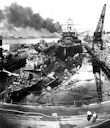
80-G-19943
USS Pennsylvania in Drydock Number One with Cassin and Downes in foreground.
--190--
2. U.S.S. HONOLULU, CRUISER (LAUNCHED IN 1936)
Honolulu was at the Navy Yard and suffered severe flooding forward. The ship was not hit, but a near-miss of a 250 kilogram bomb passed through the concrete surface of the pier and exploded about twenty feet from the hull. This resulted in an in-buckle five or six feet deep at about frame 40 and extending fore and aft about forty feet. Although the shell of the vessel was not completely opened, the flooding was extensive and could not be stopped. Due to the rupture of a magazine sea-flood, the flooding included the handling room of turret II and several storerooms and compartments.
Honolulu followed Pennsylvania in Drydock Number One, and remained in drydock for permanent repairs from 13 December until 2 January 1942. By 12 January the Yard completed permanent work to the structure, electric wiring, etc.
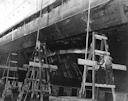
USN NR&L (MOD) 39743
USS Honolulu, showing damage to port side caused by bomb which penetrated the dock and exploded alongside the ship.
--191--
3. U.S.S. HELENA, CRUISER (LAUNCHED IN 1939)
As described, Helena was struck on the starboard side by the aerial torpedo which passed under Oglala at the 10-10 Navy Yard pier. The starboard side was opened up below the armor belt. Number 1 engine room and Number 2 boiler room flooded and the water percolated slowly into other spaces.
Drydock Number Two was in an unfinished state at that time but the contractor, the Pacific Bridge Company, arranged to use part of the drydock for Helena after obtaining suitable bilge blocks from the Navy Yard. The vessel entered drydock on 10 December, the first vessel to occupy Drydock Number Two.
Temporary repairs were made to Helena, including various piping systems, electric wiring, etc. On 21 December Helena was undocked and on 5 January 1942 she sailed on half power for the Mare Island Navy Yard where permanent repairs were completed.
4. U.S.S. MARYLAND, BATTLESHIP (LAUNCHED IN 1920)
Maryland was berthed inboard of Oklahoma. She was struck by two 15-inch armor-piercing bombs. Fortunately both bombs had a low level of detonation. The first struck the forecastle awning and tore a hole about 12 feet by 20 feet and caused some damage in the compartments below. The second entered the hull at the 22 foot water level at frame 10. It exploded within the ship and caused considerable flooding. The bow was down about five feet.
Since a dry dock was not available, the Navy Yard, assisted by the forces afloat, made repairs without docking. A small caisson was fitted over the hole on the port side. When sufficient pumping facilities were available to control the flooding, temporary repairs were easy to complete. Maryland was fully repaired and ready for action by 20 December.
5. U.S.S. TENNESSEE, BATTLESHIP (LAUNCHED IN 1919)
Tennessee was moored inboard of West Virginia and became wedged hard against the forward quay as the latter ship settled and finally sank to the
--192--
bottom. Arizona's oil fire engulfed the stern of the vessel and caused serious fires aft, especially in the officers' quarters on the second deck.
The explosion of the magazines aboard Arizona showered Tennessee with burning powder and debris. The forward magazines were purposely flooded as a precaution against the many fires on the ship. These fires were ominous for a long period and were so intense as to warp the stern plates and cause some pulling out of hull rivets.
In order to minimize fires the vessel played several water hoses over the stern to keep the burning oil on the water at a distance. Also the engines were turned over to make five knots and the wake was effective in keeping the oil clear of the ship. There was no movement of the ship even when the engines were run at ten knots. This shows how securely the ship was wedged between West Virginia and the quay.
The vessel was struck by two bombs of the 15 or 16-inch armor-piercing type from high-level bombers. Both bombs had a low order of detonation, or perhaps did not explode at all.

USN NR&L (MOD) 39744
USS Tennessee, showing penetration of bomb through catapult and top of turret III.
--193--
The first bomb hit the centerline gun of turret II, causing the barrel to crack. All three guns were rendered inoperable. The second bomb passed through the roof plate of turret III and damaged the structure and the rammer of the left gun.
Several attempts were made to free the ship. About 650,000 gallons of oil were removed by pumping while work progressed on the quay and its buffer. The work proved more onerous than expected and was finished by dynamite blasting about 16 December. In the meantime, repair ship Medusa and the Navy Yard patched the warped plates by welding, and blanked off a number of air ports. When Tennessee was finally freed she was moved to the Navy Yard where all inside damage was repaired. The ship was ready for service by 20 December .
6. U.S.S. VESTAL, REPAIR SHIP (LAUNCHED IN 1908)
Vestal was berthed outboard of the ill-fated Arizona. The first torpedo which hit the latter ship probably passed under Vestal. That vessel saw many of the torpedoes which hit Arizona and some which missed both ships.
Vestal was struck with two bombs which were dropped by dive-bombers early in the attack. They were, from Japanese surrender accounts, the 250 kilogram type although the ship assumed that they were the 15 or 16-inch armor-piercing variety. The first bomb hit the forecastle about 0805 and passed through several decks at about frame 43. This bomb exploded in the metal storeroom where the prevalence of metal products deadened the explosion and prevented the bomb from passing through other decks or the shell. Consequently there was no flooding, but the lower platform deck and other structures were badly ruptured.
The second bomb was dropped from an elevation of about 1000 feet and struck the ship aft. It passed entirely through the vessel before exploding, and caused serious flooding. It lowered the stern about ten feet and produced a port list of about seven degrees.
When the fuel oil between the two ships became ignited the captain of Vestal decided to move. The vessel got underway about 0830, aided by two tugs as the ship's steering gear was inoperative. After coming to anchor it was decided that the damage was so extensive as to warrant beaching. Accordingly she got underway again at 0950 and grounded herself on Aiea Shoal.
--194--

USN NR&L (MOD) 39745
USS Vestal after beaching.
Vestal was a repair ship, and her own artisans undertook the repair work. The temporary work was quite satisfactory but Vestal was placed in drydock as soon as one was available at the Navy Yard. The Yard finished permanent repairs on 18 February.
The lesson to be learned from Vestal's experience is that water-tight integrity cannot be counted on in the case of older vessels. This ship was about thirty-three years old at the time, and it was found that flooding was progressive through the bulkhead and deck boundaries which supposedly were watertight.
7. U.S.S. RALEIGH, CRUISER (LAUNCHED IN 1922)
Raleigh was struck by a torpedo early in the attack. Like Utah, she occupied a berth usually used by an aircraft carrier. At 0756 the two torpedoes were dropped about 300 yards from the ship. One hit the ship below the eighty pound armor belt and another passed about twenty-five yards ahead of the ship. The one which hit the ship caused immediate flooding of the two forward boiler rooms and the forward engine room.
--195--
General Quarters was sounded at once, and the anti-aircraft battery went into action promptly. Men not at the guns were ordered to jettison weights on the port side, especially those high up on the ship.
About 0900 the ship received a bomb hit from a dive-bomber. This was dropped from about 800 feet and passed through three decks and out the side of the ship. It exploded clear of the vessel at frame 112 and caused damage typical of a near-miss. Luckily the compartment, which held 3,500 gallons of aviation gasoline, was left intact.
The ship counterflooded, but the construction of the ship was not favorable to a great deal of counterflooding as loss of buoyancy was more important than list. Due to defective hatches the main deck had some free water surface, which, added to that produced by the damage, was almost fatal. The jettisoning of topside weights and the reduction of free surface by pumping water from the main deck saved the ship. It certainly would have
--196--
been lost in a seaway, as it developed negative stability. This was gradually overcome, partly by lashing an available barge alongside.

80-G-32448
USS Raleigh after taking one torpedo hit amidships and one bomb hit aft.
Raleigh is an unusual case. The ship was almost lost even with moderate damage. The Commander Battleships commended the captain and crew for saving the ship by remedial actions.
The ship's force and repair ships repaired most of the inside damage to the ship, after removing almost all of the fuel, oil, and water which were aboard. It was not until 3 January that the Navy Yard had Drydock Number One available. Then the Yard completed permanent repairs to the hull and bulkheads until undocking on 14 February. Soon Raleigh departed on one engine for Mare Island where new engine parts were provided and electrical repairs made.
8. U.S.S. CURTISS, SEAPLANE TENDER (LAUNCHED IN 1940)
The seaplane tender Curtiss was moored near the Ford Island Air Station. General Quarters was immediately sounded and all guns were in action within five minutes. By 0825 the enemy planes were repulsed. At 0840
--197--
Curtiss sighted a submarine periscope at 700 yards and promptly opened fire when the submarine partly surfaced. Two hits were made by 5-inch projectiles from number 3 gun.
Damage to Curtiss resulted from an enemy aircraft colliding with the forward crane. The enemy plane burned on the boat deck. This occurred at 0905. Another bombing attack occurred at 0912. One bomb fell on the mooring buoy aft and two bombs fell alongside. Fragment damage from these three bombs was considerable. Another bomb struck the starboard side of the boat deck, passed through three decks, and exploded on the main deck causing considerable damage.
These bombs were about 250 kilograms, measured about 12 inches in diameter, and carried about 130 pounds of TNT. They were released by dive-bombers from a height of about 300 to 400 feet.
The widespread damage caused by fragments to the piping, electric wires, steam lines, and ammunition supply, etc. overshadowed entirely the structural damage which they caused. Even the after engine room was affected by fragments from the bomb hit. Many fires were started and these were difficult to extinguish due to smoldering cork insulation and poor lighting.
Much of the fragment damage could have been prevented by use of some armor, which was forbidden in auxiliary vessels under the arms limitation treaties. Later designs provided two-inch splinter protection for sixty percent of the length, as well as splinter protection for gun, fire control, and ship control stations.
The Navy Yard undertook repairs to Curtiss on two separate availabilities; the first was from 19 to 27 December. When replacement parts were received, Curtiss was in the Yard from 26 April to 28 May 1942. At that time final repairs were made.
9. U.S.S. HELM, DESTROYER (LAUNCHED IN 1937)
We have seen how Helm got underway promptly and patrolled the waters for submarines outside of Pearl Harbor. She was attacked by a dive-bomber at 0915 when about five miles southwest of Aloha Tower. Helm reported that the enemy fighter dropped two bombs from a height of about 1000 feet. The first fell about 100 to 150 feet off the port bow, and the other about 30 feet to starboard abreast frame 10.
The second bomb deluged with water the forecastle and the gun director.
--198--
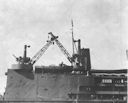
80-G-3270l
USS Curtiss, showing starboard crane which was struck by Japanese aircraft out of control.
No fragments were observed. The forward part of the ship suffered considerable damage from the near-miss. The foundation of the gun director steadily grew worse, and the flooding forward was severe in the peak tanks and forward compartments. Some damage occurred due to short circuiting and kicking out of circuit breakers in the forward part of the ship.
Helm was drydocked in the Yard's marine railway on 15 January 1942. Here permanent repairs were made to the shell plating, structure forward, gun directors, and electrical lines. The shell plating showed the effects of the near-miss. Shear lines were seen forward of bulkhead 14. The practical effects of the near-miss were in accordance with the naval architectural theory.
--199--
Contents
Previous Chapter (11) * Next Chapter (13)
